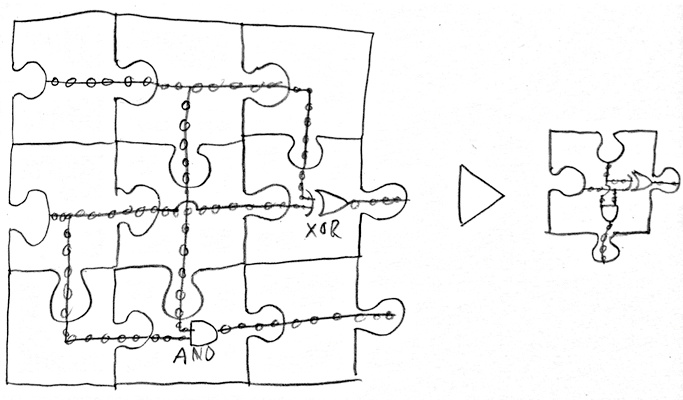Puzzle circuits

As part of my residency at Culture at Work I'm working on alternate ways of thinking about computing that are more tactile, explorable and concrete. I want to try a bunch of different ideas, turn them into prototypes, and see what can best help me pull back the silicon curtain.
My first one is called Puzzle Circuits. This is designed to be a version of digital logic that's easy to play with and understand. Each logic gate, switch, or component is represented as a piece of a jigsaw puzzle. Inputs and outputs are on the edges of the piece and the jigsaw tabs make the connection, preventing you from mixing up outputs and inputs.
All the traces are illuminated with LEDs when active, so you can always see all the state in the system at once. Actual digital logic has some extra complexity that you could sweep under the rug, including how to get power to all the gates, pull-down resistors etc. The idea would be that you could just concentrate on the logic gate level of abstraction without worrying about the electrical engineering.
This would take two forms: a physical representation made of actual puzzle pieces cut from PCBs with logic gates soldered on to them, and a software representation that you can use in a web browser. The browser version would be easy to prototype with, so I'll start with that, but the goal is to have both.
Other than allowing people without the hardware the ability to play with the ideas, this would also serve an important purpose: making meta-pieces. You could assemble a bunch of virtual pieces on your computer, then write that logic into a programmable puzzle piece that you can use like any other.
Far from being a novelty, I think the ability to make pieces that are made of pieces, that themselves are made of pieces, is a fundamental part of what makes computation what it is. There is a kind of fractal self-similarity that lets you express information at any level of abstraction.
That said, the whole goal is that it can scale with your level of interest. You can get started just plug some buttons into some logic gates and a speaker and have fun bleeping and blooping, but when you're ready to do more complex things the idea can increase in complexity to match your ambitions.
